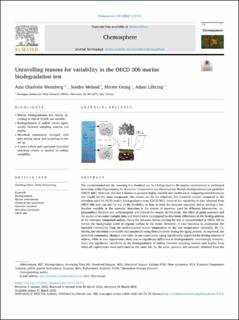| dc.contributor.author | Wennberg, Aina Charlotte | |
| dc.contributor.author | Meland, Sondre | |
| dc.contributor.author | Grung, Merete | |
| dc.contributor.author | Lillicrap, Adam David | |
| dc.date.accessioned | 2022-07-12T10:09:49Z | |
| dc.date.available | 2022-07-12T10:09:49Z | |
| dc.date.created | 2022-04-13T09:17:02Z | |
| dc.date.issued | 2022 | |
| dc.identifier.citation | Chemosphere. 2022, 300, 134476. | en_US |
| dc.identifier.issn | 0045-6535 | |
| dc.identifier.uri | https://hdl.handle.net/11250/3004642 | |
| dc.description.abstract | The recommended test for assessing if a chemical can be biodegraded in the marine environment is performed according to the Organisation for Economic Cooperation and Development Marine biodegradation test guideline (OECD 306). However, this test is known to generate highly variable test results when comparing interlaboratory test results for the same compound. One reason can be the relatively low bacterial content compared to the inoculum used for OECD readily biodegradation tests (OECD 301). Some of the variability in data obtained from OECD 306 tests can also be due to the flexibility on how to store the seawater inoculum before starting a test. Another variable in the seawater inoculum is the source of seawater used by different laboratories, i.e., geographical location and anthropogenic activities at the source. In this study, the effect of aging seawater and the source of seawater (sample time and depth) were investigated to determine differences in the biodegradation of the reference compound aniline. Aging the seawater before starting the test is recommended in OECD 306 to reduce the background levels of organic carbon in the water. However, it also functions to acclimatize the bacterial community from the environmental source temperature to the test temperature (normally 20 °C). Herein, the microbial community was monitored using flowcytometer during the aging process. As expected, the microbial community changed over time. In one experiment, aging significantly improved the biodegradation of aniline, while in two experiments, there was no significant difference in biodegradation. Interestingly however, there was significant variability in the biodegradation of aniline between sampling seasons and depths, even when all experiments were performed in the same lab, by the same operator and seawater obtained from the same source. This highlights the need for a more robust and consistent microbial inoculum source to reduce variability in seawater biodegradation tests. | en_US |
| dc.language.iso | eng | en_US |
| dc.publisher | Elsevier | en_US |
| dc.rights | Navngivelse 4.0 Internasjonal | * |
| dc.rights.uri | http://creativecommons.org/licenses/by/4.0/deed.no | * |
| dc.title | Unravelling reasons for variability in the OECD 306 marine biodegradation test | en_US |
| dc.type | Peer reviewed | en_US |
| dc.type | Journal article | en_US |
| dc.description.version | publishedVersion | en_US |
| dc.rights.holder | © 2022 The Authors. | en_US |
| dc.source.pagenumber | 9 | en_US |
| dc.source.volume | 300 | en_US |
| dc.source.journal | Chemosphere | en_US |
| dc.identifier.doi | 10.1016/j.chemosphere.2022.134476 | |
| dc.identifier.cristin | 2017128 | |
| dc.relation.project | Norges forskningsråd: 160016 | en_US |
| dc.source.articlenumber | 134476 | en_US |
| cristin.ispublished | true | |
| cristin.fulltext | original | |
| cristin.qualitycode | 1 | |

